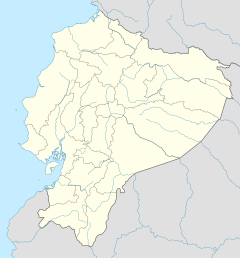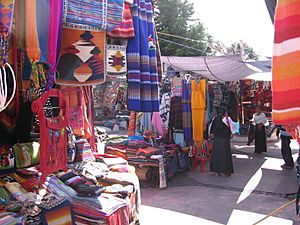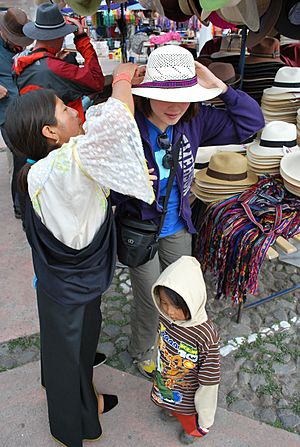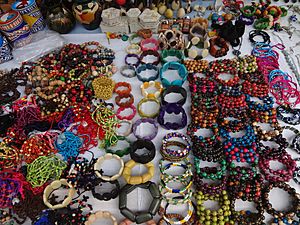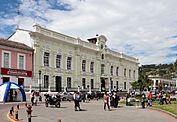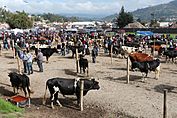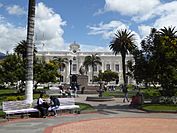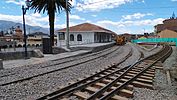Otavalo (city) facts for kids
Quick facts for kids
Otavalo
|
|
|---|---|
|
Town
|
|
| Country | |
| Province | Imbabura |
| Canton | Otavalo Canton |
| Area | |
| • Town | 11.68 km2 (4.51 sq mi) |
| Elevation | 2,532 m (8,307 ft) |
| Population
(2022 census)
|
|
| • Town | 41,718 |
| • Density | 3,571.7/km2 (9,251/sq mi) |
| Time zone | UTC-5 (ECT) |
| Climate | Cfb |

Otavalo is a lively town in Imbabura Province, Ecuador. It is the main town of Otavalo Canton. Many people living here are part of the Otavalo indigenous group.
In 2022, about 41,718 people lived in Otavalo. The town is high up in the mountains, at about 2,532 meters (8,307 feet) above sea level. It is surrounded by tall volcanoes like Imbabura (4,630 meters), Cotacachi (4,995 meters), and Mojanda. The current mayor of Otavalo is Mario Conejo.
Contents
The Famous Otavalo Market
The Otavalo people are well-known for their beautiful woven textiles. These are usually made from wool. You can find them at the famous Saturday market. While Saturday is the biggest market day, you can still find many goods throughout the week in the Plaza de los Ponchos. Many local shops also sell handmade blankets, tablecloths, and other items.
The market area was designed in 1970 by a Dutch architect named Tonny Zwollo. It features mushroom-shaped concrete umbrellas with benches.
What You Can Find at the Market
On busy market days, almost a third of Otavalo is filled with stalls. You can find many interesting things here. These include textiles, jewelry made from tagua nuts, musical instruments, and dream catchers. There are also leather goods, traditional costumes, and hand-painted items. You might even see spices, fresh foods, and spools of wool.
As Otavalo has become a popular place for tourists, some items sold in the market are made in nearby factories. However, you can find more unique, handmade products in nearby villages or at the Museo Viviente Otavalango.
Tourism and Local Crafts
Otavalo used to be mostly a farming area because of its rich volcanic soil. But with more tourism, the town now focuses on making handicrafts. This has made the Saturday market a popular stop for visitors to Ecuador. Tourism is now the town's main business. Because of this, Otavalo has more hotels, hostels, and tour operators than other towns its size. People from Otavalo, called Otavaleño, have also been very successful selling their goods in other countries.
Many nearby villages are famous for their own special crafts. For example, Cotacachi is known for its leather products. In San Antonio, people specialize in wood carving. The main street there shows off many carved statues, picture frames, and furniture.
Fun Places to Visit
Besides the market, Otavalo and the area around it have other cool places to explore.
- Peguche Waterfall: A beautiful natural waterfall.
- Lagos de Mojanda: A group of stunning lakes.
- Museo Viviente Otavalango: This living museum is located in an old factory called "antigua fabrica San Pedro." Long ago, indigenous Otavaleños worked here in very tough conditions. After the factory closed, local people bought the land. They turned it into a museum and community space. The museum shows what Otavaleño life was like in the past and how it is today. Visitors can see craftspeople making textiles and farming. The museum also hosts concerts, weddings, and community meetings.
- Parque Condor: A short trip from town, this is a bird rescue center. They teach people about protecting wild birds. You can watch daily flight shows to see some of the birds flying.
Traditional Clothing
Otavaleña women wear special traditional clothes. They often have white blouses with fancy embroidery and lace sleeves. They wear black or dark skirts over cream or white underskirts. Their long hair is tied back with a colorful woven band, about 30 cm long. This band often matches a similar one wrapped around their waists. They also wear many gold beads around their necks. The more strands and thicker the beads, the older and wiser they are. They also wear tightly wrapped strings of coral beads around each wrist.
Otavaleño men traditionally wear white trousers and dark blue ponchos.
Music and Festivals
Otavalo is also famous for its traditional music and musicians. Every June, the music of Otavalo is a big part of the Inti Raymi festival. This festival celebrates the southern winter solstice. Many music groups from Otavalo travel worldwide. They share their music, sometimes called Andean New Age, which has become very popular.
Interesting Buildings
While the market is a main draw, Otavalo also has some beautiful buildings to see.
Parque Bolívar
Parque Bolívar, also known as Parque Central, is the main park in Otavalo. It is a well-kept and pretty place. Around the park, you will find the impressive City Hall (Edificio Municipal). There is also a Catholic church called Iglesia de San Luís. This church has an octagonal clocktower. The original church was built between 1676 and 1679. It was damaged by an earthquake in 1868. It was rebuilt from 1880 to 1890 in a renaissance style. Inside, you can see many artworks and a baroque altar from 1869.
Iglesia El Jordán
Iglesia El Jordán is another notable church. It was built in 1775 and also suffered damage from earthquakes in 1868 and 1906. Rebuilding started in 1925 and finished in 1964. It has a renaissance and Greek style. The front of the church and its two clocktowers have columns with fancy Corinthian capitals.
The Railway Station
The railway station is in the southern part of the town center. It is located behind the Copacabana Market. The station is 2,532 meters (8,307 feet) above sea level. The railway line from Otavalo to Ibarra was closed around 1980. But it was reopened in 2015 for tourists. Traveling by train from Otavalo to Ibarra is now a popular activity for visitors.
Climate
| Climate data for Otavalo, elevation 2,556 m (8,386 ft), (1971–2000) | |||||||||||||
|---|---|---|---|---|---|---|---|---|---|---|---|---|---|
| Month | Jan | Feb | Mar | Apr | May | Jun | Jul | Aug | Sep | Oct | Nov | Dec | Year |
| Mean daily maximum °C (°F) | 20.0 (68.0) |
19.9 (67.8) |
20.1 (68.2) |
19.9 (67.8) |
20.4 (68.7) |
20.3 (68.5) |
19.9 (67.8) |
20.1 (68.2) |
20.4 (68.7) |
20.5 (68.9) |
20.6 (69.1) |
19.4 (66.9) |
20.1 (68.2) |
| Mean daily minimum °C (°F) | 8.4 (47.1) |
7.9 (46.2) |
8.4 (47.1) |
8.9 (48.0) |
8.8 (47.8) |
8.5 (47.3) |
7.6 (45.7) |
7.3 (45.1) |
7.6 (45.7) |
8.5 (47.3) |
9.1 (48.4) |
8.8 (47.8) |
8.3 (47.0) |
| Average precipitation mm (inches) | 62.0 (2.44) |
86.0 (3.39) |
90.0 (3.54) |
110.0 (4.33) |
72.0 (2.83) |
36.0 (1.42) |
17.0 (0.67) |
26.0 (1.02) |
54.0 (2.13) |
92.0 (3.62) |
107.0 (4.21) |
62.0 (2.44) |
814 (32.04) |
| Average relative humidity (%) | 83 | 84 | 83 | 83 | 83 | 85 | 82 | 80 | 79 | 82 | 82 | 82 | 82 |
| Source: FAO | |||||||||||||
Gallery
See also
 In Spanish: Otavalo para niños
In Spanish: Otavalo para niños


